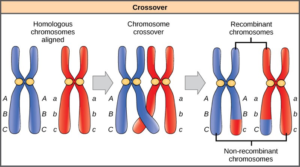Do Linked Genes Assort Independently
68 Linked Genes Violate the Law of Contained Assortment
Although all of Mendel's pea institute characteristics behaved according to the constabulary of independent assortment, we now know that some allele combinations are non inherited independently of each other. Genes that are located on split, not-homologous chromosomes will always sort independently. Nonetheless, each chromosome contains hundreds or thousands of genes, organized linearly on chromosomes like beads on a string. The segregation of alleles into gametes tin be influenced by linkage, in which genes that are located physically close to each other on the same chromosome are more probable to exist inherited every bit a pair. However, because of the process of recombination, or "crossover," it is possible for two genes on the same chromosome to behave independently, or as if they are non linked. To understand this, let u.s.a. consider the biological footing of factor linkage and recombination.
Homologous chromosomes possess the same genes in the same lodge, though the specific alleles of the gene can exist dissimilar on each of the ii chromosomes. Recall that during interphase and prophase I of meiosis, homologous chromosomes first replicate and then synapse, with like genes on the homologs aligning with each other. At this stage, segments of homologous chromosomes substitution linear segments of genetic material (Figure 17). This procedure is called recombination, or crossover, and it is a mutual genetic process. Because the genes are aligned during recombination, the factor order is not contradistinct. Instead, the effect of recombination is that maternal and paternal alleles are combined onto the same chromosome. Across a given chromosome, several recombination events may occur, causing extensive shuffling of alleles.

When two genes are located on the same chromosome, they are considered linked, and their alleles tend to exist transmitted through meiosis together. To exemplify this, imagine a dihybrid cantankerous involving bloom color and plant height in which the genes are next to each other on the chromosome. If one homologous chromosome has alleles for alpine plants and red flowers, and the other chromosome has genes for short plants and yellowish flowers, so when the gametes are formed, the tall and red alleles will tend to go together into a gamete and the brusk and xanthous alleles volition get into other gametes. These are chosen the parental genotypes considering they have been inherited intact from the parents of the individual producing gametes. But different if the genes were on different chromosomes, at that place will be no gametes with tall and yellow alleles and no gametes with brusque and ruby alleles. If yous create a Punnett foursquare with these gametes, yous volition come across that the classical Mendelian prediction of a 9:3:3:1 upshot of a dihybrid cross would not apply. As the distance betwixt two genes increases, the probability of ane or more than crossovers between them increases and the genes behave more like they are on separate chromosomes. Geneticists take used the proportion of recombinant gametes (the ones not like the parents) as a measure of how far apart genes are on a chromosome. Using this information, they have constructed linkage maps of genes on chromosomes for well-studied organisms, including humans.
Mendel'south seminal publication makes no mention of linkage, and many researchers accept questioned whether he encountered linkage but chose not to publish those crosses out of business that they would invalidate his independent assortment postulate. The garden pea has seven chromosomes, and some have suggested that his option of 7 characteristics was not a coincidence. Yet, even if the genes he examined were non located on separate chromosomes, information technology is possible that he simply did not find linkage because of the extensive shuffling effects of recombination.
References
Unless otherwise noted, images on this page are licensed under CC-BY 4.0 by OpenStax.
OpenStax, Biological science. OpenStax CNX. May 27, 2016 http://cnx.org/contents/GFy_h8cu@10.57:cUeevuaC@3/Laws-of-Inheritance
Do Linked Genes Assort Independently,
Source: https://openoregon.pressbooks.pub/mhccbiology102/chapter/linked-genes-violate-the-law-of-independent-assortment/
Posted by: bennettwasat1989.blogspot.com


0 Response to "Do Linked Genes Assort Independently"
Post a Comment